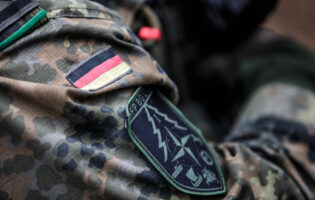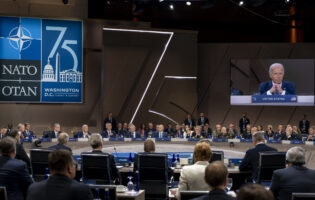German Jihad: Reading the History of al-Qaeda through a German Lens

Guido Steinberg
German Institute for International and Security Affairs
Dr. Guido Steinberg was a DAAD/AICGS Research Fellow at AICGS in Fall 2017.
In Germany, Guido Steinberg works for at the German Institute for International and Security Affairs (Stiftung Wissenschaft und Politik, SWP) in Berlin. An Islamicist by training, he has worked as a research coordinator at the Free University of Berlin and an advisor on international terrorism in the German Federal Chancellery (2002-2005).
Since 2006, he has served as an objective expert witness in all major trials against Islamist terrorists in Germany, and has also testified in Austria, Denmark, the Czech Republic, and the United States. He regularly comments on Middle East affairs and terrorism on German and international media, most frequently on Deutsche Welle TV in German, English, Arabic, and Spanish.
In his academic work, Guido Steinberg focusses on Saudi Arabian and Gulf history and politics, Islamism and Salafism as well as Islamist Terrorism. He has published widely on these topics, including: German Jihad. The Internationalization of Jihadist Terrorism (New York: Columbia University Press, 2013).
At AICGS, he will work on the research project “Countering the Islamic State: German and U.S. Policy Options.” He will give an overview of the threat posed by Islamist terrorists to Germany, analyze the measures invoked by the German government and its allies to counter the threat, and offer his views on additional efforts to improve the effectiveness of counter-terrorism on both sides of the Atlantic.
A new book by Guido Steinberg
Whenever American counterterrorism officials met with their German colleagues in 2004 and 2005, the radicalization of European Muslims was one of the main subjects of debate. The terrorist attacks in Madrid in March 2004 and London in July 2005 raised the fear that young, angry Muslims might pose a threat to the U.S. America’s argument was that European governments did not integrate these Muslims, who then radicalized and turned to terrorism. Furthermore, as most of these militants possessed European passports, the fear was that they might travel to the U.S. and attack targets on American soil. At the time, most German interlocutors rejected this argument by pointing to the situation in their country. If the lack of integration was indeed an important factor for the radicalization of jihadists, Germany—with its dismal record regarding the integration of Turks, Kurds, and Arabs—would have long become a beacon of jihadism, which it clearly was not in 2005. Instead, many German officials argued that the predominantly Turkish Muslim population in Germany seemed to be immune to jihadist-style radicalization.
In 2006 and 2007, it turned out that the Germans had been terribly wrong about domestic militants. First, the Sauerland cell, made up of two ethnic Turks and two Germans, converted to Islam, was arrested after plotting attacks on American targets in Germany in September 2007. Second, it turned out that the group had recruited about a dozen of their friends and acquaintances to undergo training in the Pakistani tribal areas, where in 2006 the “Sauerland four” had joined an Uzbek jihadist organization, named Islamic Jihad Union (IJU), which was close to al-Qaeda. Most of these recruits were German Turks and Kurds, highlighting the increasing popularity of jihadist thought among non-Arabs in Germany. Whether this new trend was connected to the shortcomings of German integration policies is still subject to debate, but the argument that Turks were not attracted by jihadist ideology was clearly disproved.
From 2007 until 2010, a continuously growing number of young German recruits found their way to the training camps of al-Qaeda, IJU, and the Islamic Movement of Uzbekistan (IMU). It soon turned out, though, that the internationalization of the jihadist social base did not stop with the integration of Turks and Kurds into the movement. Instead, the German “travel groups”, as they were called by the security authorities, did not show any of the ethnic or national homogeneity which had been so typical of al-Qaeda groups in the past. This trend is most evident when one compares the original Hamburg cell, which provided al-Qaeda with three pilots for the attacks of September 11, 2001, with the Hamburg travel group, which left the city in March 2009 in order to join the jihadist fighters in the Pakistani tribal areas. The first Hamburg cell consisted of Arabs only, with a small group of North African supporters forming around the pilots: the Egyptian Mohammed Atta, the Emirati Marwan al-Shehhi and the Lebanese Ziyad Jarrah, and their liaison to al-Qaeda, the Yemeni Ramzi Binalshibh. Quite in contrast, the 2009 Hamburg travel group no longer showed ethnic homogeneity and reflected the growing attractiveness of jihadism for a wider range of ethnic communities and nationalities. The group consisted of an ethnic Algerian with French nationality, three Afghans, two Iranian converts from Shiism, a German-Syrian, two German resettlers from the former Soviet Union, and— also a novel— two women. This change mirrored the overall development of the jihadist movement, which broadened its social base after 2001 by recruiting ever greater numbers of non-Arabs. In 2001, al-Qaeda was still an exclusively Arab organization; in 2013 it had become more international than it had ever been.
For Germany, the recruitment of German Muslims by jihadist organizations led to the emergence of a new threat. The 9/11 plotters had studied at German universities for some years but had not sunk roots in German society, instead remaining strongly connected to their societies of origin in the Middle East. As a consequence, they did not consider attacking Germany, but rather used Hamburg as an ideal operating base for the 9/11 plot. From 2006 on, a more homegrown threat emerged, with increasingly more sociological Germans (i.e. people of different origin who have spent most of their lives in Germany) joining al-Qaeda and allied organizations. As a consequence, al-Qaeda not only had a reason to target Germany—due namely to its presence in Afghanistan—but also recruits with a profound knowledge of the country and who were ready to perpetrate attacks there.
The threat for Germany became obvious with the Sauerland plot in 2007, but the danger increased in the following years due to the rising number of recruits in the training camps in Pakistan. In 2009, several dozen Germans represented the single largest group among Western recruits in the Pakistani tribal areas. In 2010 and 2011, this prompted the al-Qaeda leadership to devise a larger plot in Europe, which has been called “Europlot” by the media. Several recruits then present in Waziristan were sent back to Europe and tasked with building new structures for the organization and with coordinating attacks. As most of the recruits were Germans, the plot seems to have focused on Germany, where several individuals and small groups of returnees were arrested in 2010 and 2011. The plot’s only “success” seems to have been the assassinations of seven people by the French Algerian Mohammed Merah in Montauban and Toulouse in March 2012.
For this reason, the significance of the Europlot lies not so much in its actual content, which was foiled by European security authorities with American help. Rather, it is important because it was part of a new al-Qaeda strategy to rebuild its structures in Afghanistan, Africa and Europe, and regain the capacity to perpetrate attacks like the ones in New York and Washington in 2001. With the arrests of its German returnees and the death of important leaders in Pakistan, it must have become clear to al-Qaeda that what was perhaps its last-ditch attempt to remain a relevant terrorist actor had failed. It is more than coincidence, then, that only days after most of the returnees to Germany were arrested in May 2011, al-Qaeda published a video in which its leaders asked their followers worldwide to follow a strategy of “individual jihad”. Instead of travelling to Waziristan to train there, the prospective fighters should stay in their home countries and perpetrate simple attacks without financial and logistic support by al-Qaeda. Judged by the rising number of this type attack since 2011, al-Qaeda’s ideology is now strong enough to prompt recruits to act on its behalf. Nevertheless, for an organization which had always shown a marked inclination towards bureaucratic procedures and had always insisted on exerting as much central command and control as possible during its operations, the content of the video comes close to a capitulation. In fact, it is unclear whether al-Qaeda in Pakistan and Afghanistan will survive the coming years.
With the Europlot, the history of al-Qaeda came full circle. It rose to world prominence as a result of the 9/11 attacks, which had partly been organized in Hamburg and had been executed by three pilots from there. In 2011, the organization tried to rebuild itself in Germany, and the failure of its German recruits meant the collapse of all its neatly devised new plans to rebuild and restructure. The failure of the Europlot might therefore have heralded the end of al-Qaeda as we came to know it in 2001.
Read the Book:
Guido W. Steinberg: German Jihad. On the Internationalization of Islamist Terrorism, New York: Columbia University Press (Columbia Studies in Terrorism and Irregular Warfare), 2013. Available on Amazon.
Guido Steinberg is an Islamicist with the Middle East and Africa Research Division of the German Institute for International and Security Affairs (SWP). He has previously served as Advisor on International Terrorism at the Federal Chancellery in Berlin, and as Research Coordinator at the Interdisciplinary Center Social and Cultural History of the Middle East, Freie Universität Berlin. His areas of expertise are the Arab World and the Gulf region, Islamism and Islamist terrorism.









